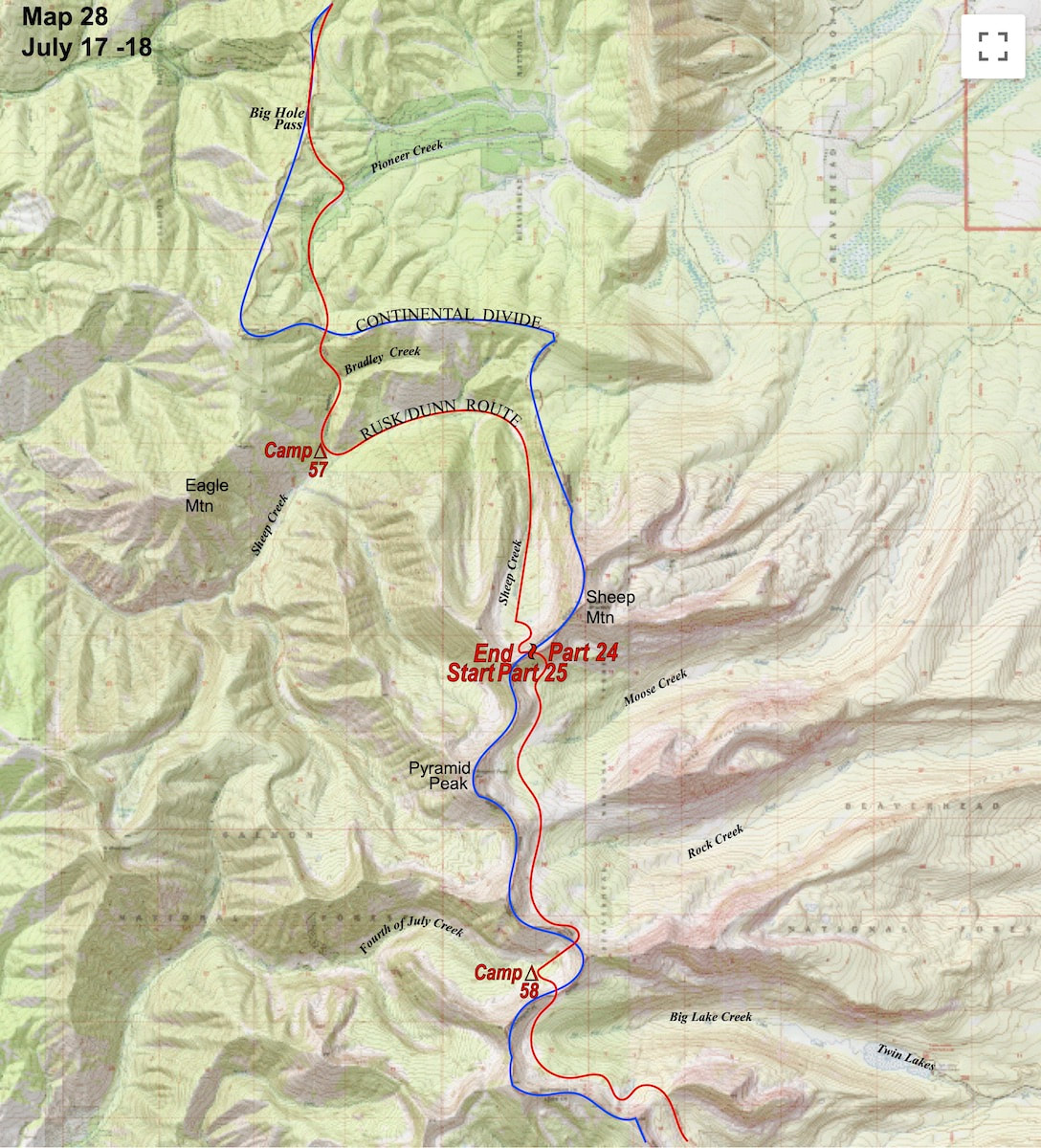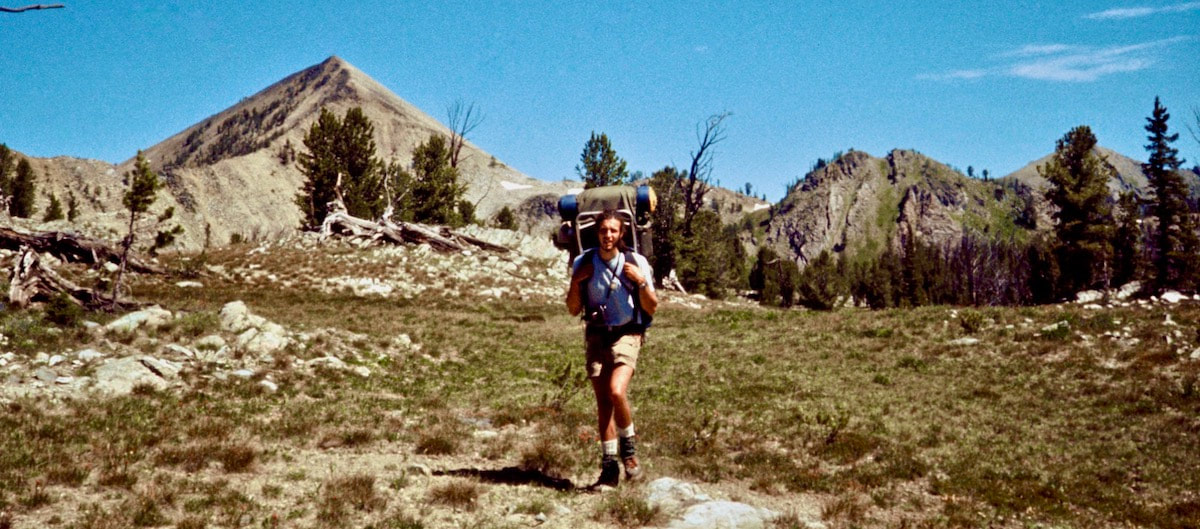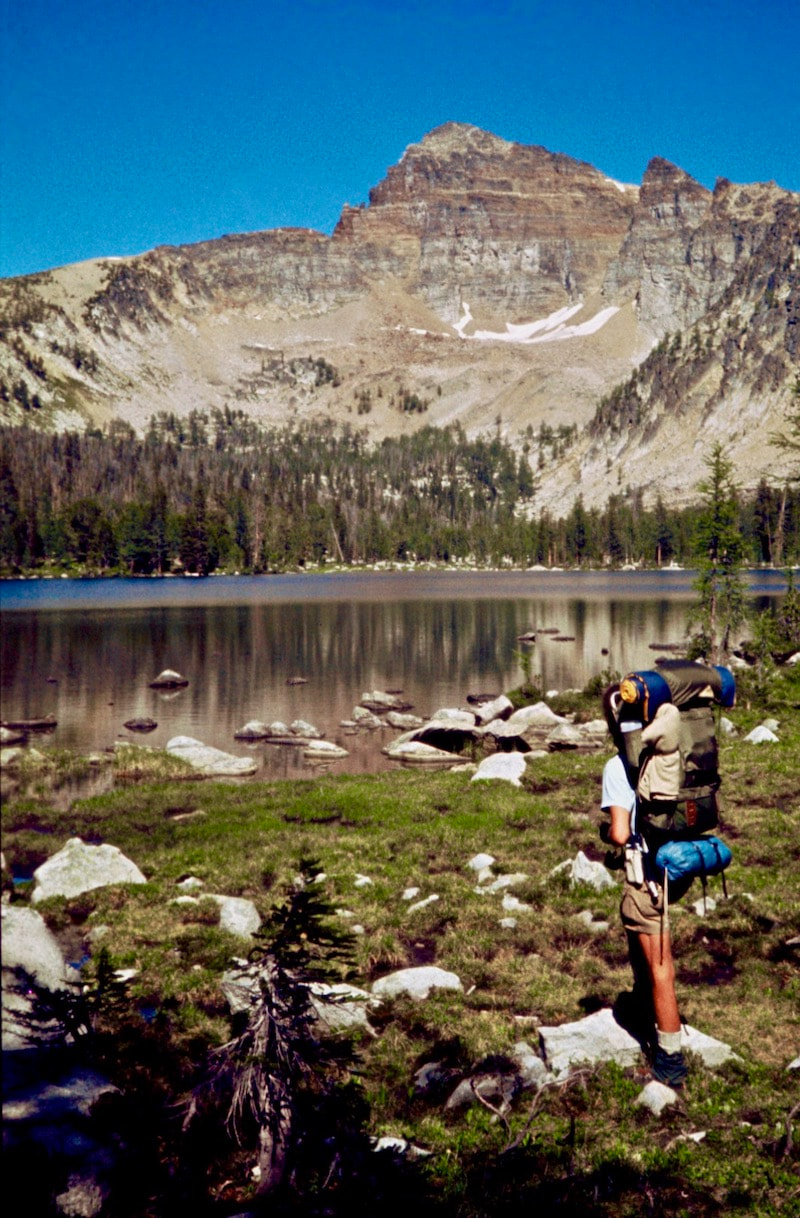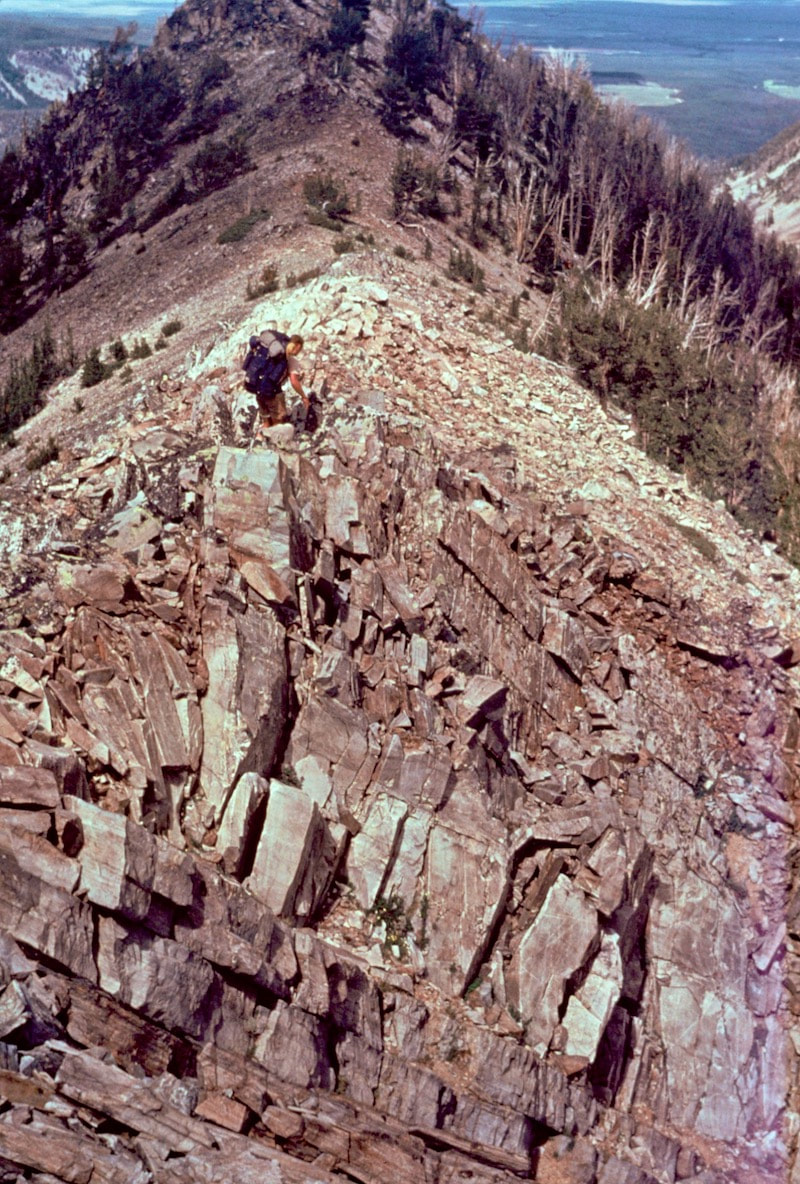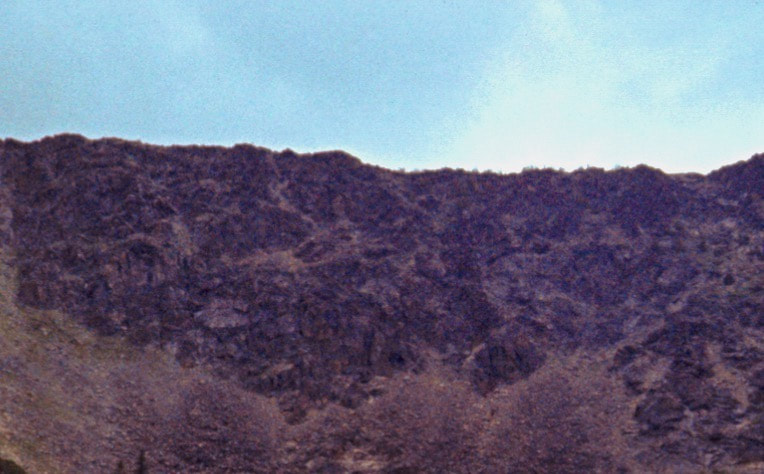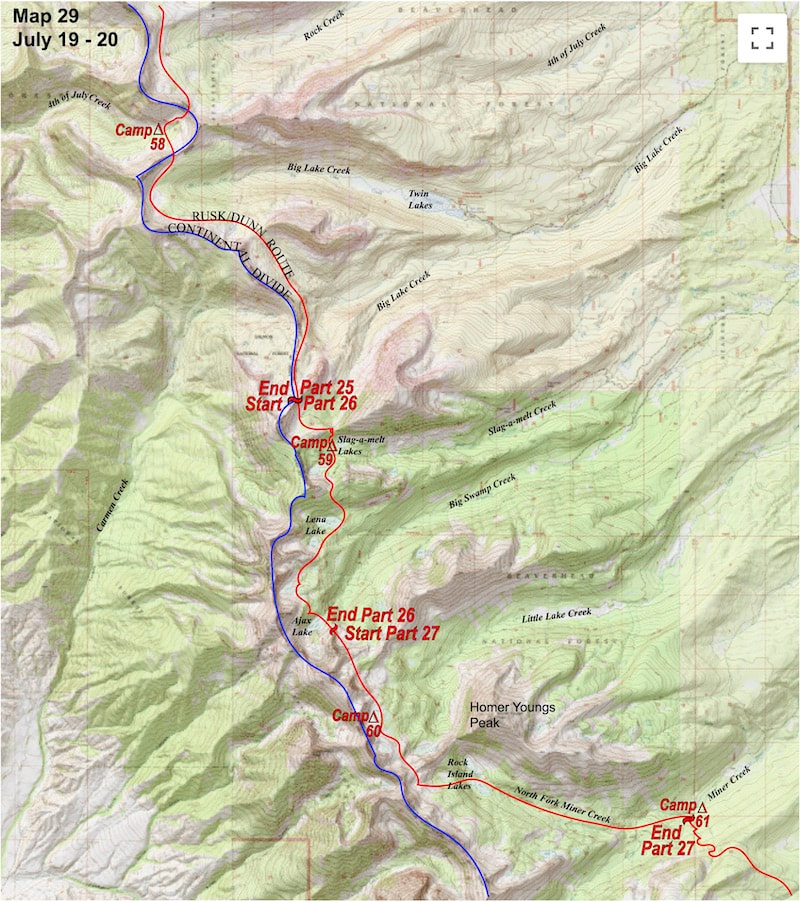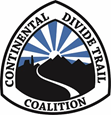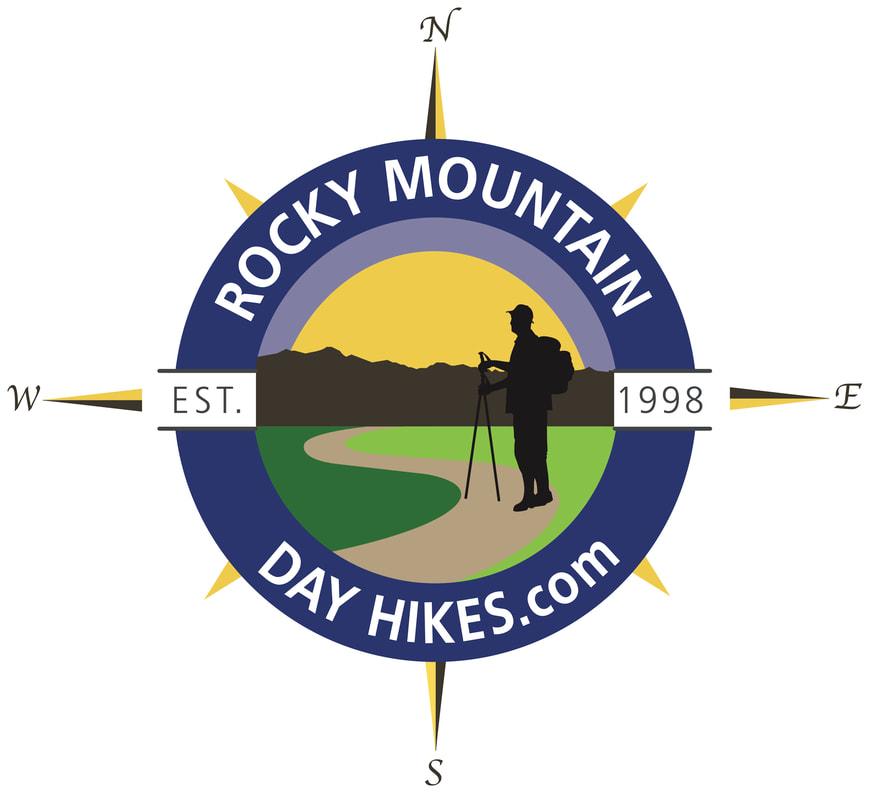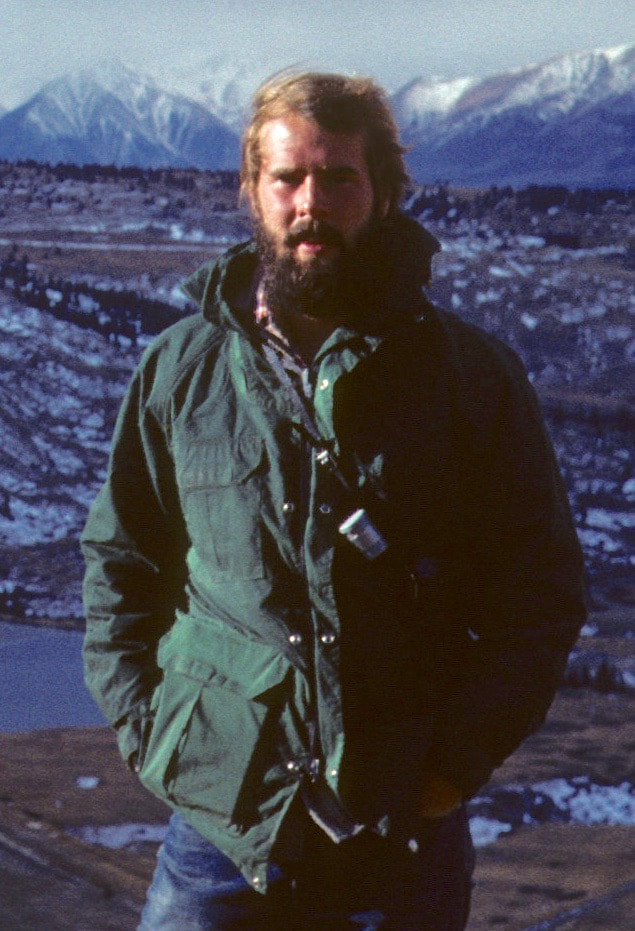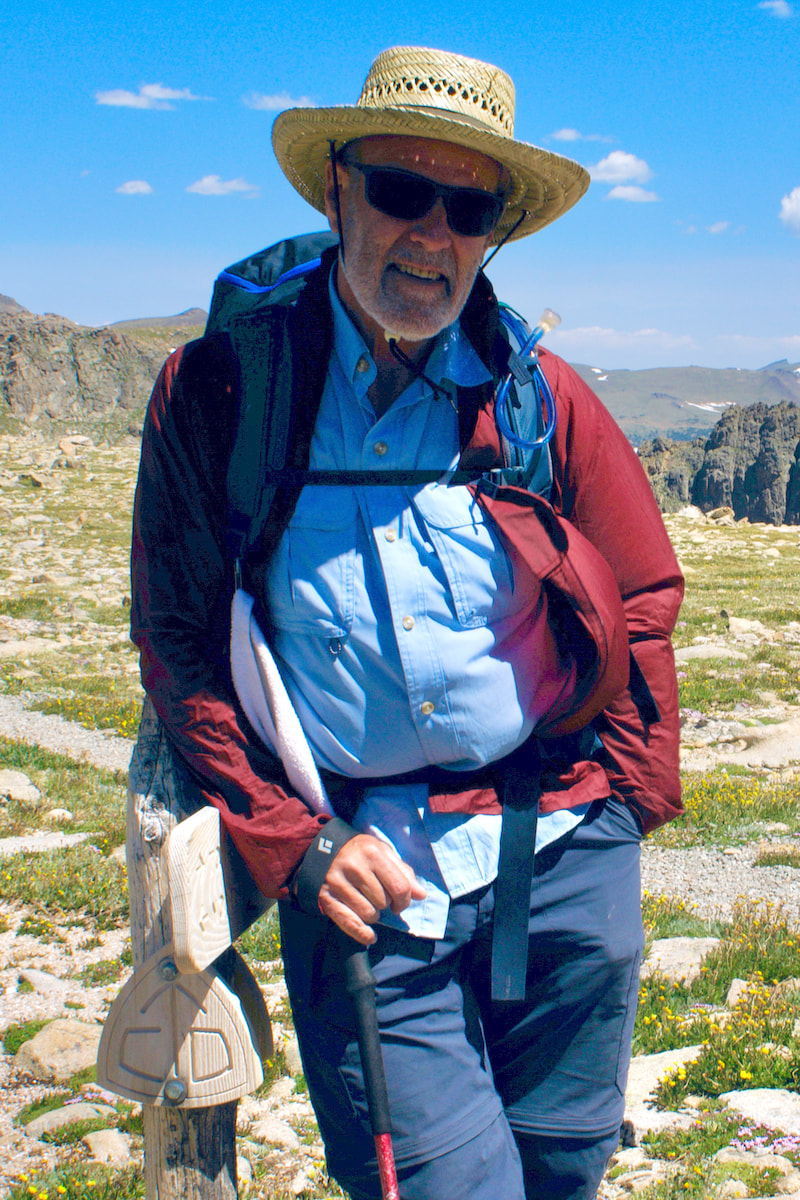The Continental
|
|
July 18 - 19 Anaconda-Pintler Wilderness, MT (Go to Pt 1) Before we committed to the descent we dropped our packs and pulled out the lunch bag. We didn’t talk much about how we were going descend and after picking through our lunch ration for the day there was really nothing left to do but to start plunge-stepping down the steep scree to the splintered rocks below. The descent was sketchy but turned out to be not quite as steep or as long as coming up the north side had been. We bottomed out at the debris pile collecting at the base of the ridge then traversed back onto level ground.
but I just didn’t think my legs could carry me over another pass and Craig kept mentioning his knee joints at the bottom of each excruciating descent. We were done-in so we set about finding a tent site. The upper reaches of the valley were narrow and steeply sloped and despite being well practiced at searching out tent platforms it still took a while to find a spot that was not quite big enough nor exactly flat enough for the tent but, with a little ground-clearing and shoring, adequate enough to wedge in a camp. It rained on and off throughout the night and the next morning everything was wet; the trees dripped all over everything and once we got going the wet underbrush shed cold rainwater all down my bare legs. We wasted little time getting out of the brush and back in the sun to the base of a talus slope leading up to the next saddle we needed to cross. Here we were pleasantly surprised to find a wide, grassy meadow just beyond the talus that made easy work of reaching yet another pass along the Divide. From the saddle we traversed gentle terrain around a cirque formed by the Continental Divide at the head of the Big Lake Creek valley. We were walking mostly through thin, open forest interspersed with stretches of alpine meadow that reached out across about a mile and a half of gentle geography. The hiking was far away from any trail and it was absolutely fantastic! The terrain was a glide and my pack felt like it was carrying half the weight.
One option was to drop down several hundred feet in elevation and slog our way around the towering peninsula on trails (a plan I did not favor much) or we could commit to a half-mile bushwhack up-valley to climb over a steeply contoured spot on the ridge that we could not yet see. I was all for sticking with the route over the ridge but, for the first time since we started the trip in Canada, Craig balked at climbing over a ridge. He was looking at the steeply stacked contours on the map and shaking his head. I was like “What?” It was not like Craig to shy away from a direct route like this. “Why don’t you want to take the short cut?” I asked. We were still in the forest and did not have a view of the terrain, so this route planning was purely speculative based on what we saw on the map. “What if we get over there and it’s too steep to get up?” Craig asked “It’s a mile out of the way if we don’t get over it. And look at the backside” he stated, pointing at the steep, south-side contours. “Oh common!” came my tactful reply “We cross shit like this all the time!” Craig didn’t respond, he just handed the map back to me and shouldered his pack. “What?” I said, raising my voice. “Alright, let’s go” he replied, clearly irritated. ‘Well, okay’ I thought ‘the saddle it is then’ slinging my pack and marching off into the woods. We ambled across the long, sprawling pass through open forest until finally we got to where we could get a view of the ridge and our intended route over the saddle. Well, it did indeed look steep.
The grassy ramps had made quick work of the climb to the top of the ridge and I was about to give Craig the whole ‘I told you so’ attitude when we walked across the saddle and looked down the other side.
0 Comments
Leave a Reply. |
Kip RuskIn 1977, Kip Rusk walked a route along the Continental Divide from Canada to Mexico. His nine month journey is one of the first, documented traverses of the US Continental Divide. Montana Part 1 - Glacier Ntl Pk Part 2 - May 11 Part 3 - May 15 Part 4 - May 19 Part 5 - May 21 Part 6 - May 24 Part 7 - May 26 Part 8 - June 2 Part 9 - June 5 Part 10 - June 7 Part 11 - June 8 Part 12 - June 11 Part 13 - June 12 Part 14 - June 15 Part 15 - June 19 Part 16 - June 23 Part 17 - June 25 Part 18 - June 27 Part 19 - June 30 Part 20 - July 5-6 Part 21 - July 7-8 Part 22 - July 9-10 Part 23 - July 11-15 Part 24 - July 17-18 Part 25 - July 18-19 Part 26 - July 19 Part 27 - July 20-21 Part 28 - July 22-23 Part 29 - July 24-26 Part 30 - July 26-30 Part 31 - July 31-Aug 1 Part 32 - Aug 1-4 Part 33 - Aug 4-6 Part 34 - Aug 6 Part 35 - Aug 7-9 Part 36 - Aug 9-10 Part 37 - Aug 10-13 Wyoming Part 38 - Aug 14 Part 39 - Aug 15-16 Part 40 - Aug 16-18 Part 41 - Aug 19-21 Part 42 - Aug 20-22 Part 43 - Aug 23-25 Part 44 - Aug 26-28 Part 45 - Aug 28-29 Part 46 - Aug 29-31 Part 47 - Sept 1-3 Part 48 - Sept 4-5 Part 49 - Sept 5-6 Part 50 - Sept 6-7 Part 51 - Sept 8-10 Part 52 - Sept 11-13 Part 53 - Sept 13-16 Part 54 - Sept 17-19 Part 55 --Sept 19-21 Part 56 Sept 21-23 Part 57 - Sept 23-25 Part 58 - Sept 26-26 Colorado Part 59 - Sept 26 Part 60 - Sept 30-Oct 3 Part 61 - Oct 3 Part 62 - Oct 4-6 Part 63 - Oct 6-7 Part 64 - Oct 8-10 Part 65 - Oct 10-12 Part 66 - Oct 11-13 Part 67 - Oct 13-15 Part 68 - Oct 15-19 Part 69 - Oct 21-23 Part 70 - Oct 23-28 Part 71 - Oct 27-Nov 3 Part 72 - Nov 3-5 Part 73 - Nov 6-8 Part 74 - Nov 9-17 Part 75 - Nov 19-20 Part 76 - Nov 21-26 Part 77 - Nov 26-30 Part 78 - Dec 1-3 New Mexico Part 79 - Dec 3-7 Part 80 - Dec 8-11 Part 81 - Dec 12-14 Part 82 - Dec 14-22 Part 83 - Dec 23-28 Part 84 - Dec 28-31 Part 85 - Dec 31-Jan2 Part 86 - Jan 2-6 Part 87 - Jan 6-12 Part 88 - Jan 12-13 Part 89 - Jan 13-16 Part 90 - Jan 16-17 Part 91 - Jan 17 End |
© Copyright 2025 Barefoot Publications, All Rights Reserved

